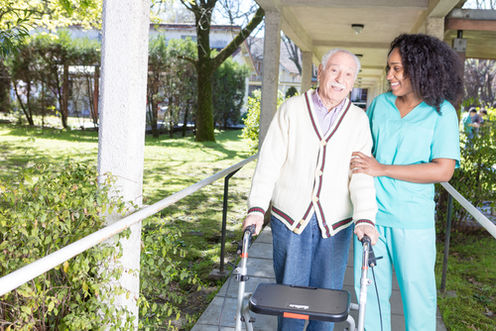
Efforts to repeal and replace Obamacare have been suspended for the time being, and many Americans are breathing a sigh of relief. But Obamacare is far from safe, and the same is true for one of the key programs – Medicaid – that the law used to expand health care coverage for millions of Americans.
While many people may think of Medicaid as a government program that helps only the nation’s poor, that is not accurate. Medicaid helps pay for – and is indeed part of estate planning strategies for – nursing home care and other forms of long-term care. Since all Americans live in communities with elderly people, will grow old themselves or have aging parents, long-term care and how to pay for it is a matter that affects us all, even if we do not realize it.
I am a professor of law and bioethics who sits on a hospital ethics committee in Cleveland and has researched aging and long-term care extensively for my scholarship. I have learned a great deal about the cost of care and the importance of Medicaid, which not enough people appreciate.
A rising expense, a growing population
Long-term care in the United States is extraordinarily expensive. The median annual cost of a private room in a nursing home is over US$92,000, and a shared room costs over $82,000. These prices will only increase in the coming years, as costs have risen by almost 19 percent since 2011.
The median price for care in an assisted living facility, which provides residents with meals and other forms of assistance but not with skilled nursing care, is over $43,500. Those who want to remain at home with the help of an in-home aide from a home care agency will pay approximately $20 an hour, which translates into $175,000 per year for round-the-clock care.
According to the U.S. Department of Health and Human Services, “70 percent of people turning age 65 can expect to use some form of long-term care during their lives.” It is important to understand that despite its high cost, long-term care is generally not paid for by Medicare, the government program that covers seniors, or by private health insurance policies.

So are most Americans financially equipped to pay on their own for nursing homes and other types of assistance when they are elderly? The answer is a resounding “no.”
A 2015 U.S. Government Accountability Office report found that “about half of households age 55 and older have no retirement savings (such as in a 401(k) plan or an IRA).”
The National Institute on Retirement Security concluded that American households had a median retirement savings account balance of just $2,500, and the median for those nearing retirement was a mere $14,500. Such meager savings make it extremely difficult for retirees to cover their out-of-pocket medical costs for co-pays, deductibles, and noncovered items such as hearing aids, which often reach several thousands of dollars per year. A prolonged period of long-term care on top of these costs is certainly not in most people’s budgets.
Medicaid and seniors
Enter Medicaid. While many may think Medicaid primarily covers poor people, about 28 percent of its overall budget is spent on long-term care.
That money is vital to seniors and to the nursing homes they live in. In 2014, Medicaid paid for 62 percent of nursing home residents. Increasingly, it covers assisted living and in-home care, which many elderly people prefer.
Medicaid is still a program that serves only financially disadvantaged individuals and has strict eligibility requirements, but people who need long-term care, including some who were middle-class, end up “spending down” their money by paying for nursing homes or other assistance out of pocket and then qualify for Medicaid. This includes many who worked hard and supported themselves and their families their entire lives but simply did not have enough retirement savings to cover the exorbitant costs of medical care and long-term care. Those who spend down are very rarely wealthy, with about 85 percent barely hanging on economically before “spending down.”
Republican proposals to repeal and replace Obamacare targeted Medicaid for significant cuts that would have affected seniors receiving long-term care. Many in Congress still hold out hope of eliminating Obamacare, and this should make all of us worried.
Medicaid and all of us
What might happen if frail and elderly people cannot receive needed care? Some will have to turn to loved ones for extra support.

Family and friends already bear much of the burden of caring for the elderly. According to the Alzheimer’s Association, over 15 million Americans tended to dementia patients in 2016, supplying an estimated 18.1 billion hours of unpaid care. Overall, older adults receive $470 billion worth of unpaid care each year. Without Medicaid, the elderly will often need to ask more of their relatives or even to move in with them.
Caring full-time for someone who is physically disabled or has dementia can be emotionally exhausting and can lead to anxiety, depression and other mental and physical health problems; create conflicts within families; and be financially draining, especially if it affects caregivers’ ability to work outside the home.
Other elderly people will try to continue living independently without the help they need. This can create dangers for other members of their communities. They may have to drive in order to get groceries and supplies, and this can lead to more car accidents. Indeed, The American Medical Association and National Highway Traffic Safety Association state that “on the basis of estimated annual travel, the fatality rate for drivers 85 and older is nine times higher than the rate for drivers 25 to 69.” They will cook alone and perhaps forget to turn off the oven or burners, which can cause fires. And they will be at high risk of falling and needing care in emergency rooms. As more patients flood emergency rooms, the wait times for everyone will increase, and already understaffed hospitals may provide less attentive care.
These problems will only grow in the future. In 2015, 14.9 percent of the population, or 47.8 million people, were 65 and over. The number of seniors is projected to expand to almost 73 million by 2030 and to represent over 20 percent of total U.S. residents. Society will not be able to ignore their needs.
We will all be affected if elderly members of our communities cannot get needed care. Moreover, many of us will find that long-term care is unaffordable for our own loved ones or for ourselves. None of us knows whether we will develop dementia or another serious chronic condition that requires intensive care for many years.
Medicaid is not just about the poor. It is about all of us, and we should all care deeply about maintaining and strengthening it for the future.
![]()
Sharona Hoffman received financial support from Case Western Reserve University for publication of her book "Aging with a Plan: How a Little Thought Today Can Vastly Improve Your Tomorrow" (Praeger 2015).